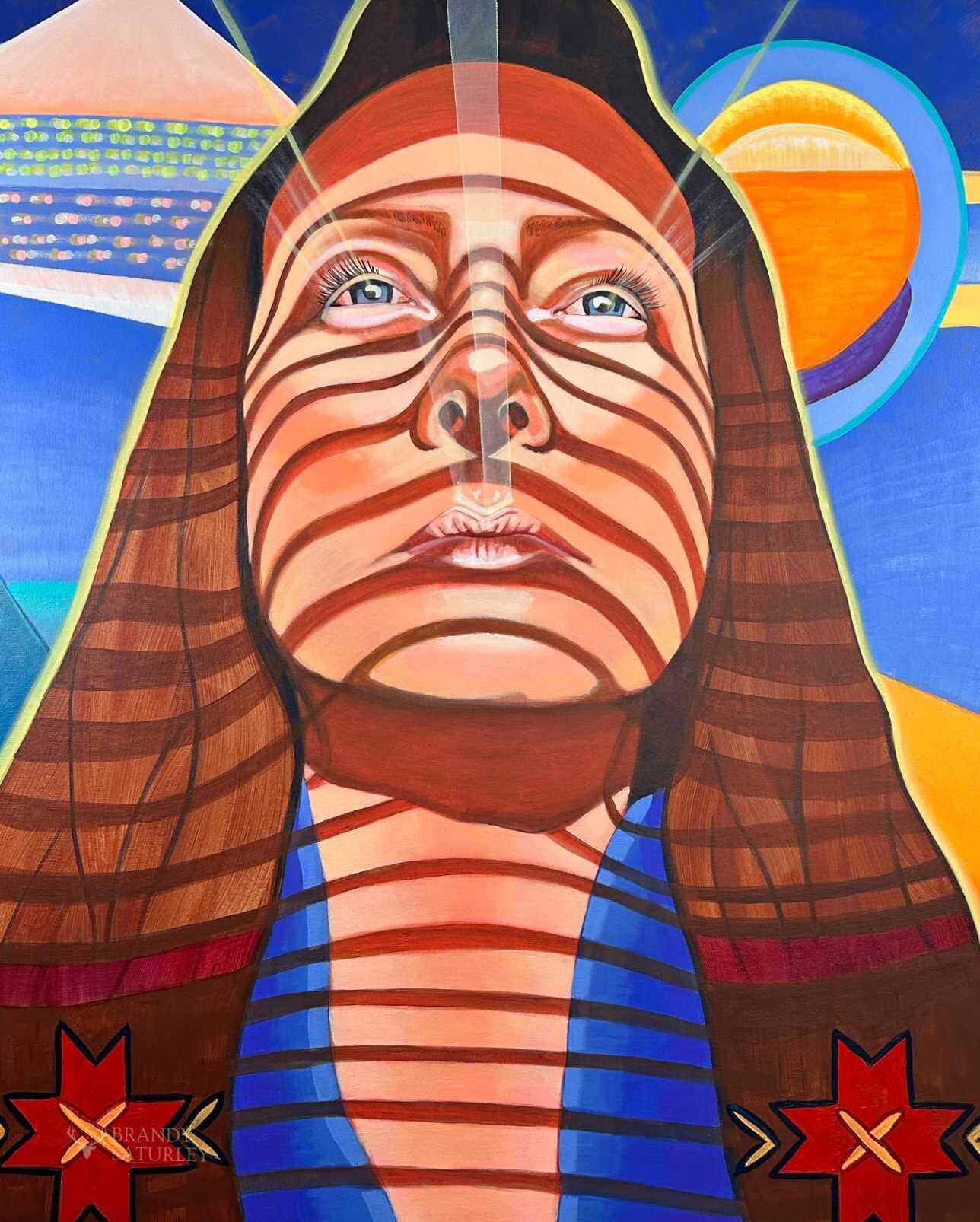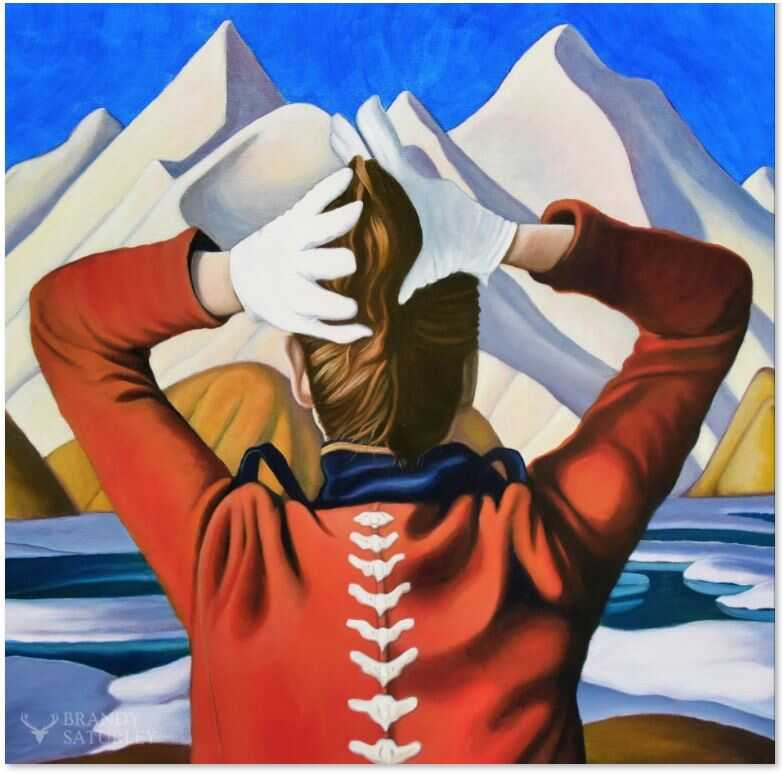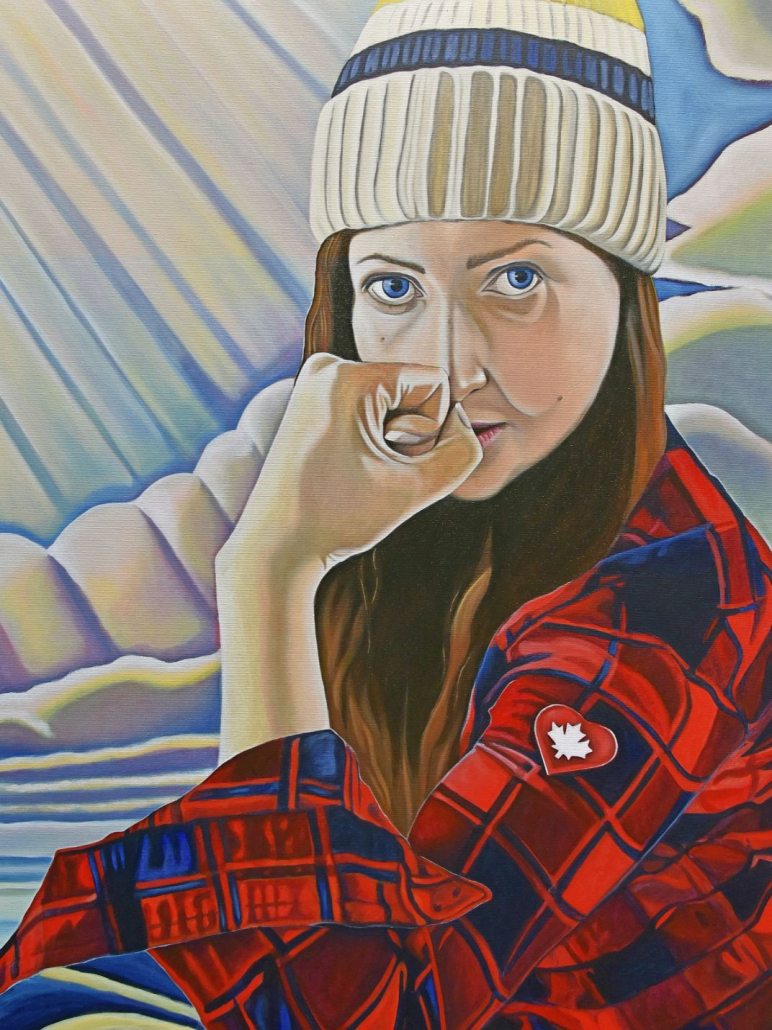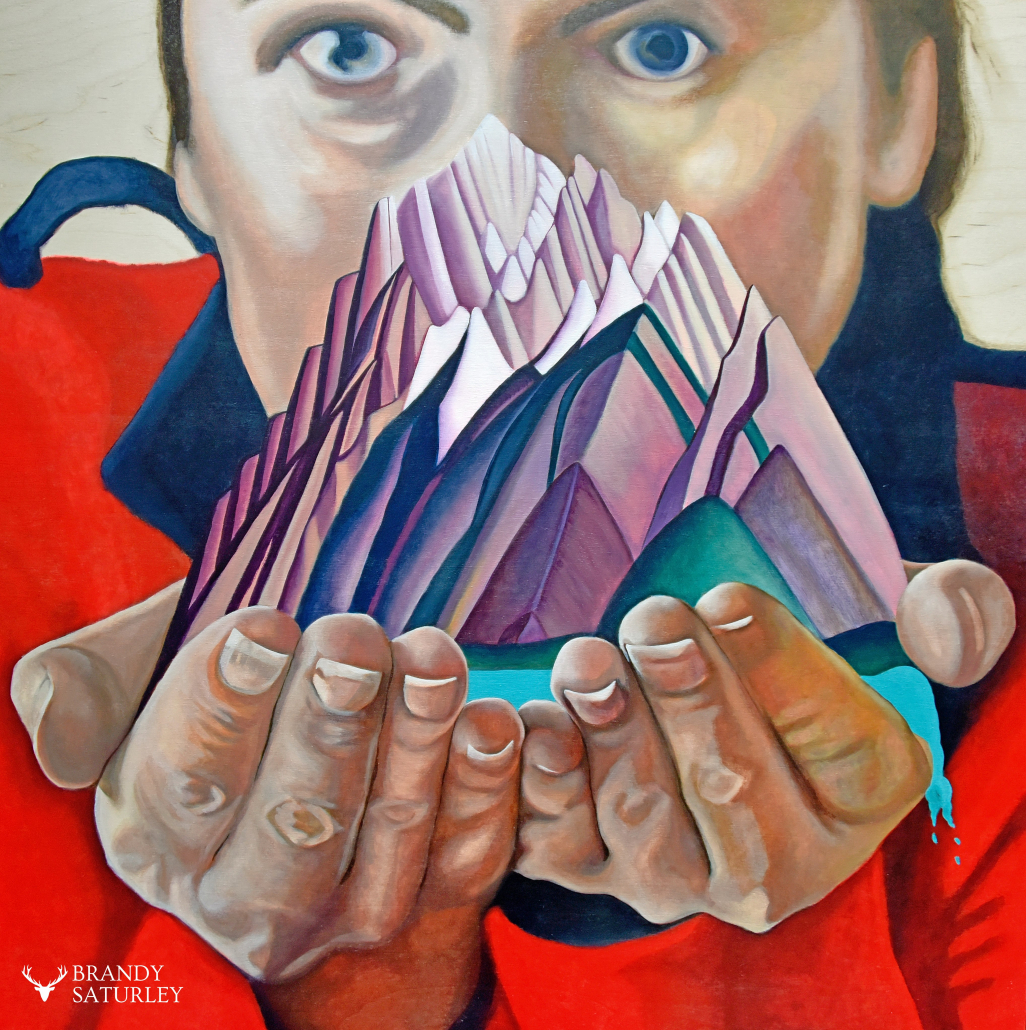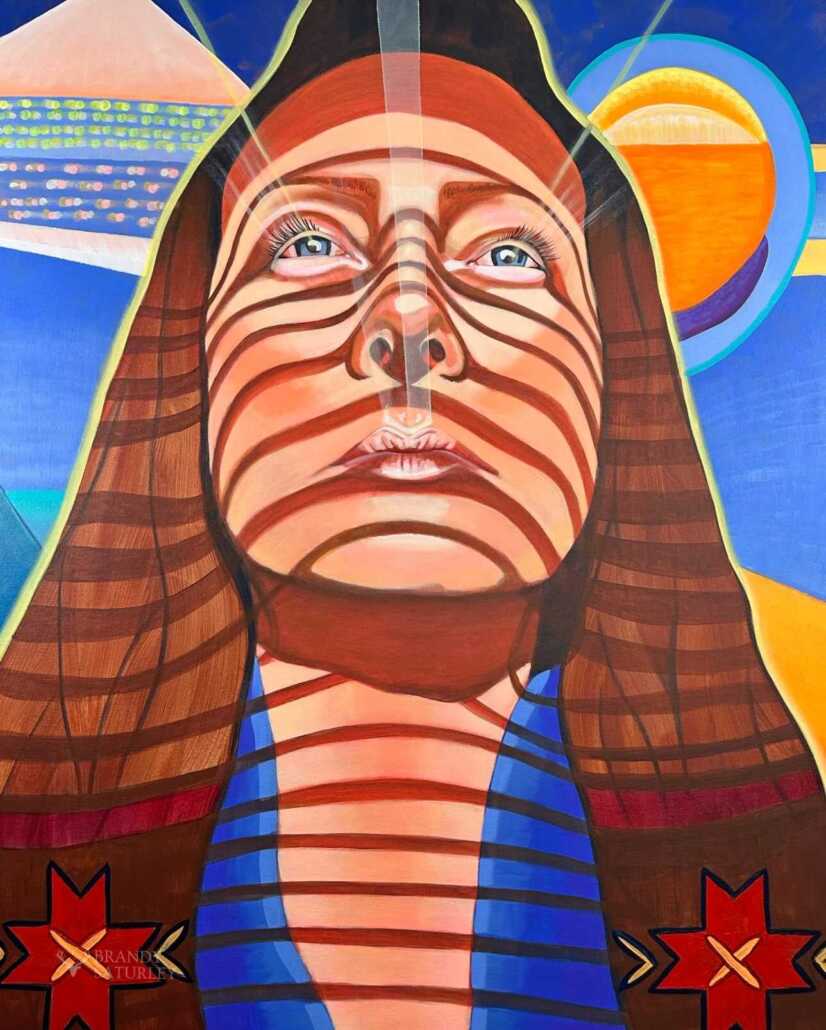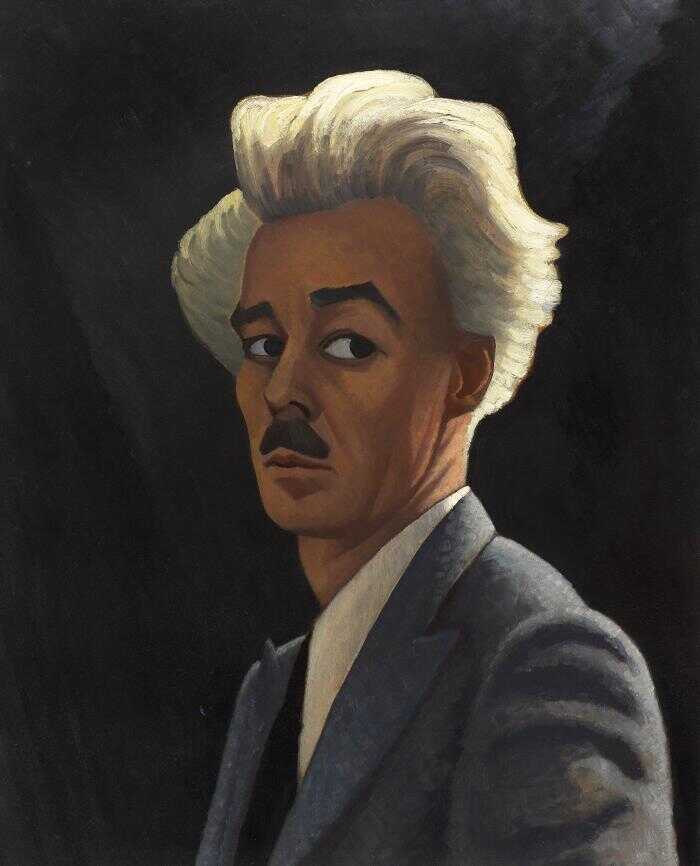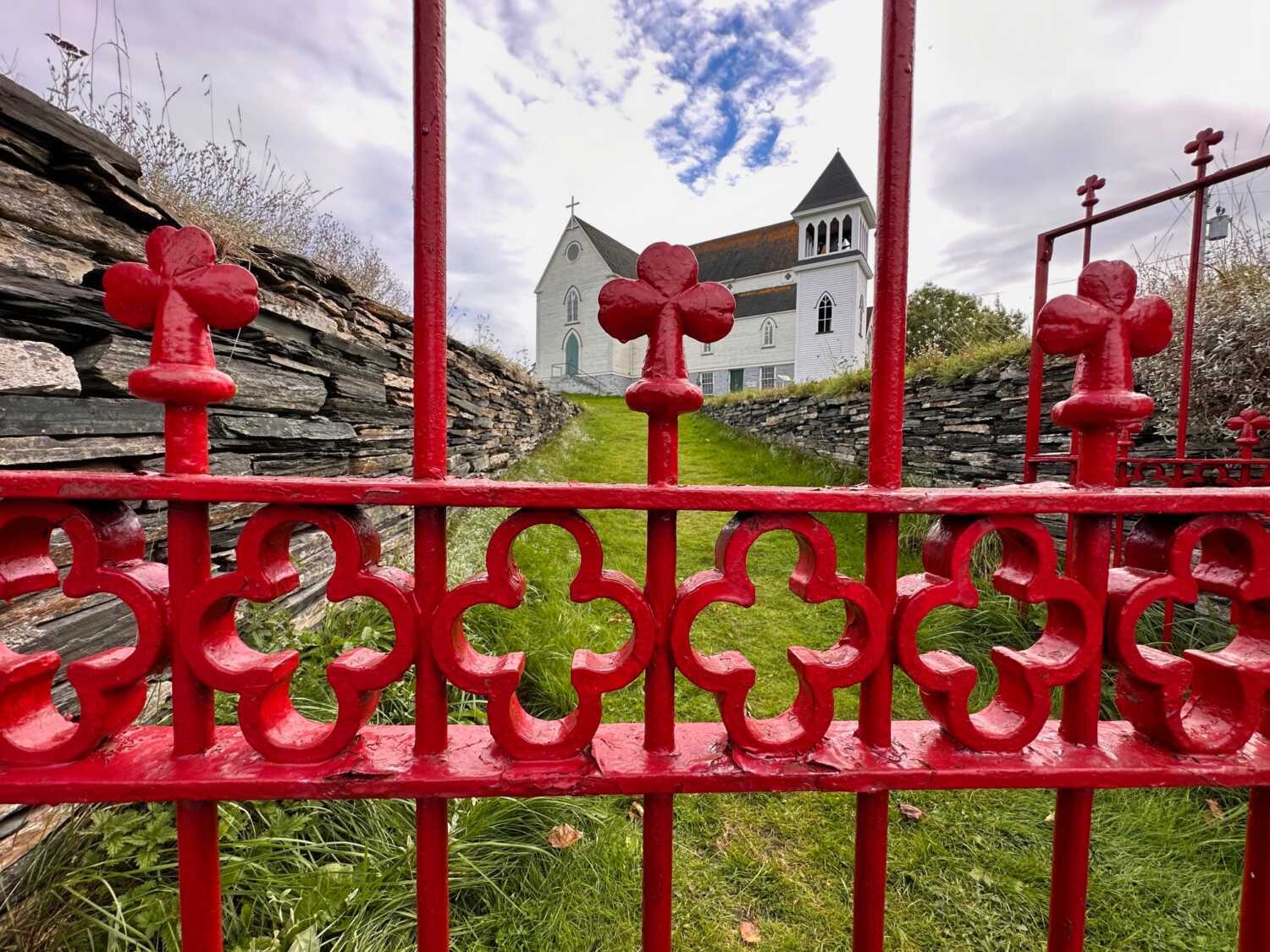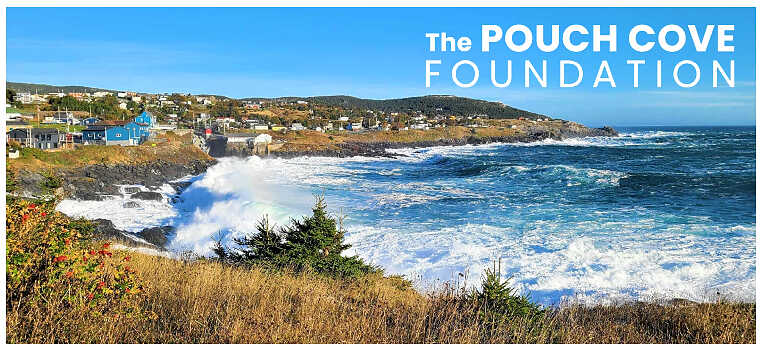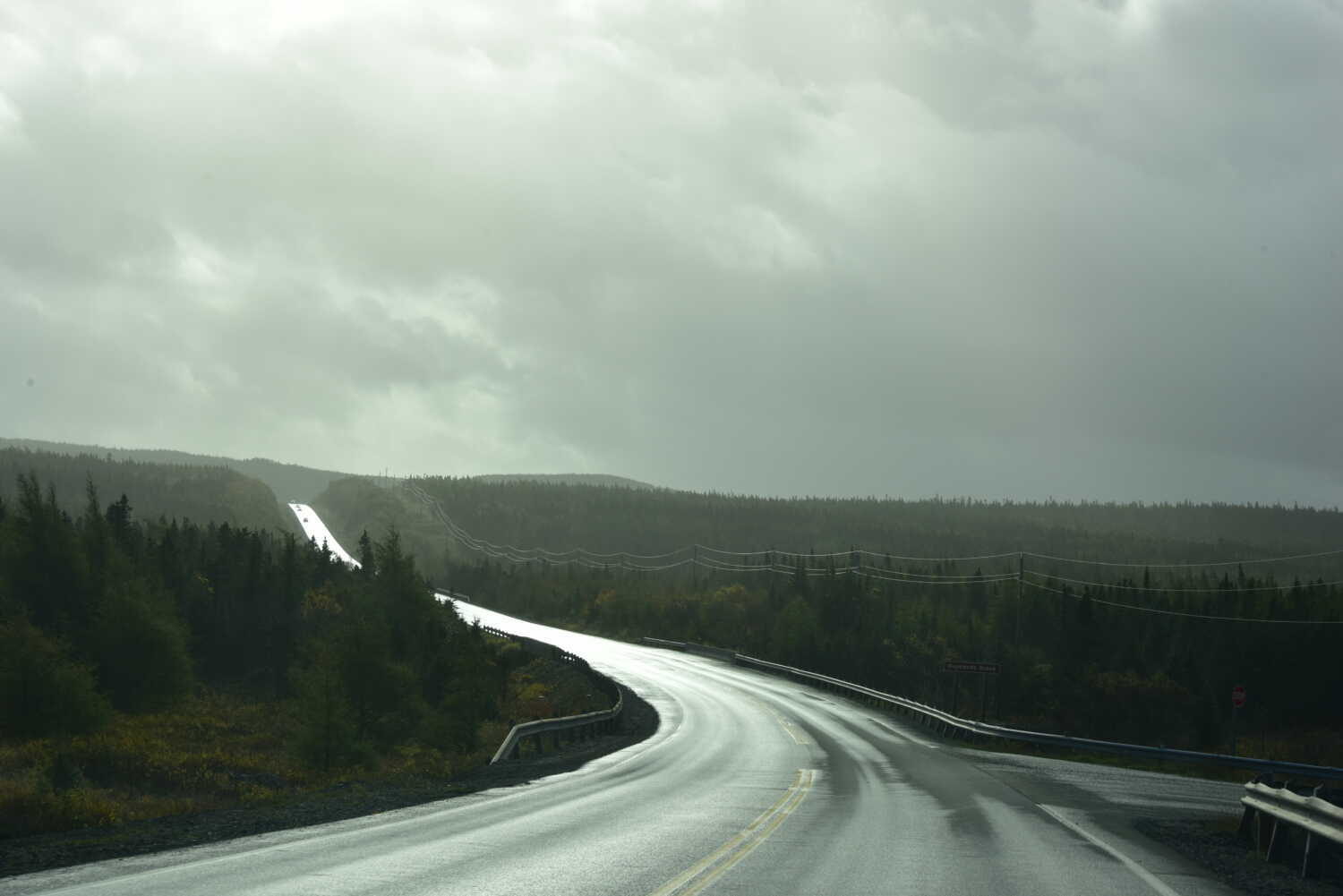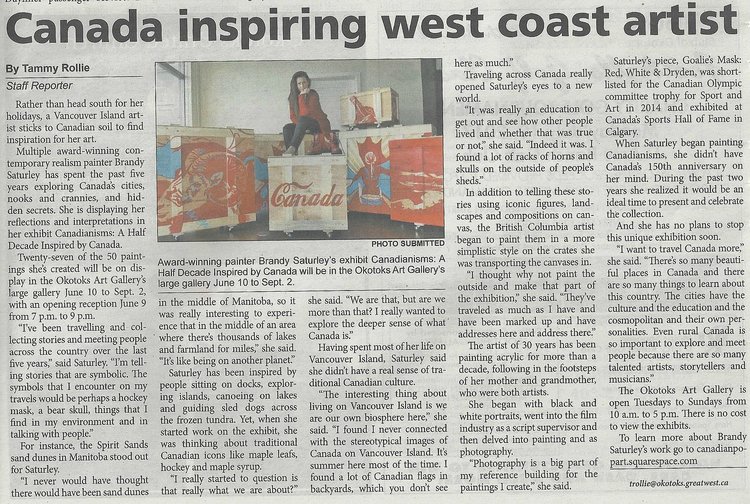Painting with Lawren Harris
Painting with Lawren Harris – putting myself in the forefront
Lawren Harris is considered one of Canada’s most prominent painters of the 20th century, known for his distinctive style that captures the essence of the Canadian landscape. I am a contemporary Canadian painter, and one of the many artists who have been inspired by Harris’s work. I have created a number of paintings, that pay homage to Harris’s artistic legacy and also make a statement about putting Canadian women artists in the forefront. These pieces are about representation, inclusion and achievement in the Canadian Art world. I am painting with Lawren Harris.
I want to talk about four paintings I have created that reference Harris’s ‘Baffin Island (1931), ‘North Shore, Lake Superior’ (1926), ‘Mountain Forms (1926) and ‘Sun and Earth’ (1945), respectively. In these works, Harris depicted the rugged and majestic Canadian landscape in a stylized, almost abstract way. Using bold colors and geometric shapes to create a sense of the landscape’s essence. My paintings similarly capture the essence of the Canadian landscape, but with their own unique style and perspective.
My use of bright, bold colors and geometric shapes is reminiscent of Harris’s style. I also add my own personal touch by including myself in the forefront of the painting, along with other elements and symbols that represent contemporary Canadian culture. I have spoken about the influence of Harris on my work, his paintings have inspired me to explore and depict the Canadian landscape in my own way. I have also spoken about the importance of paying homage to Harris and other Canadian artists who have paved the way for contemporary painters in Canada.
I have taken inspiration from Harris’s distinctive style and used it to create my own unique vision of the Canadian landscape and culture, while also paying homage to Harris’s legacy. Through my work, I am adding to the rich and diverse tapestry of Canadian art, continuing the tradition of artistic exploration and innovation that Harris helped to establish.
Here I will discuss these four paintings by Lawren Harris, and how they influenced my comment on the current culture and conversations in Canada.
Let Your Backbone Rise, 2016 – Brandy Saturley
This was the first painting where I used a painting by Lawren Harris as reference for the background of the painting. The background shows a segment of the painting, Baffin Island, painted by Harris in 1931. My career at this time was rising as I had just booked two public gallery solo exhibitions in the province of Alberta, the shows were retrospective shows of my paintings about Canadian culture and landscapes over a period of five years. I have painted myself into the painting wearing my red military style coat and wearing my the white gloves usually associated with handling artwork. My hair gathered into a formal french twist, facing the landscape boldly with arms raised. Running down the outside of the back of my coat a backbone is visible with vertebrae running outside the coat and over the spinal area of my back. I am definitely making a statement about the time in Canada, and my time as a rising woman on the Canadian art scene.
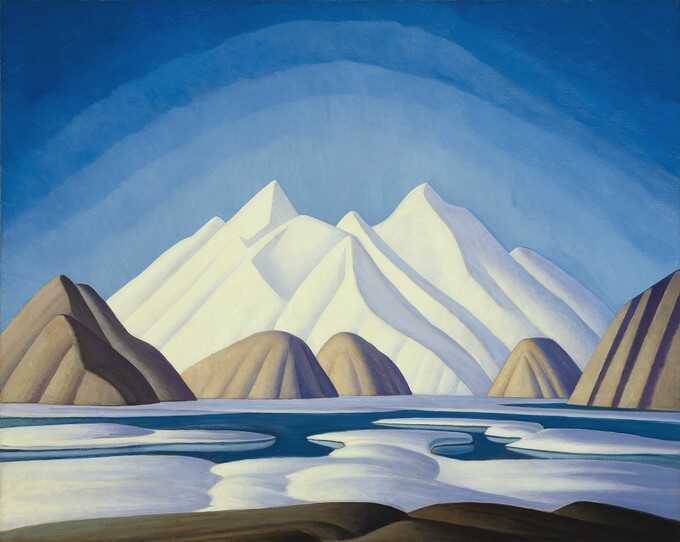
Baffin Island, 1931 – Lawren Harris
“I paint myself into these paintings because I suppose I am looking for myself in the world.”
With Hearts on Our Sleeves, 2017 – Brandy Saturley
The second painting I created with a Lawren Harris reference features a self portrait facing the viewer. The background of the piece features an abstract snippet from the Harris painting, ‘North Shore, Lake Superior’ from 1926. In this painting the ‘God’s rays’ of light through the clouds put the focus on the figure in the foreground. The year is 2017 and I made this painting while my public gallery retrospectives were moving from a gallery in Edmonton to a gallery in Calgary. In the self-portrait I am wearing a Hudson’s Bay toque and a plaid shirt (the symbol of the blue collar Canadian worker) The shirt features a heart sewn on the sleeve, with sleeves unrolled and folded backwards I am making a fist. Here I am channeling ‘Rosie the Riveter’ in my pose and gaze, though I am holding my fist tightly with head tilted down like a prize fighter.
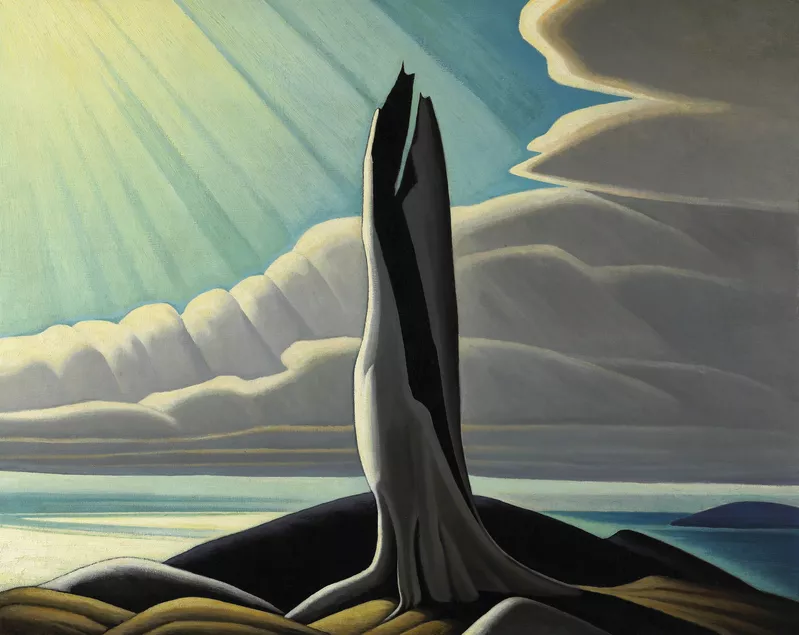
North Shore Lake Superior, 1926 – Lawren Harris
“What Harris did in painting this mountain and it subsequently selling for millions is make it possible for someone to acquire and carry this landscape wherever they roam.”
A Landscape To Go, 2017 – Brandy Saturley
The third painting with Lawren Harris is a little different. Rather than placing myself in the foreground and Harris in the background, I have placed myself in the background and I have extracated the most famous Harris landscape in the foreground. ‘Mountain Forms’ painted in 1926 became the most expensive Canadian artwork ever to sell at auction in 2016 for a whopping $11.21 million. Mountain Forms, is a renowned painting of Alberta’s Mount Ishbel in the Sawback Range of the Rocky Mountains in Banff National Park. In the painting I am holding the painting in cupped hands as I examine it closely, again dressed in my military style red coat. The lake below the mountain runs off my hand. I am examining the landscape, holding it in my hands. When you are in the Rocky Mountains of Canada you are dwarfed by the gargantuan size of these mountains. What Harris did in painting this mountain and it subsequently selling for millions is make it possible for someone to acquire and carry this landscape wherever they roam. I was also thinking about how many hands this painting has moved from during it’s time on Earth. An examination of the Canadian art market, and injecting myself into the conversation.
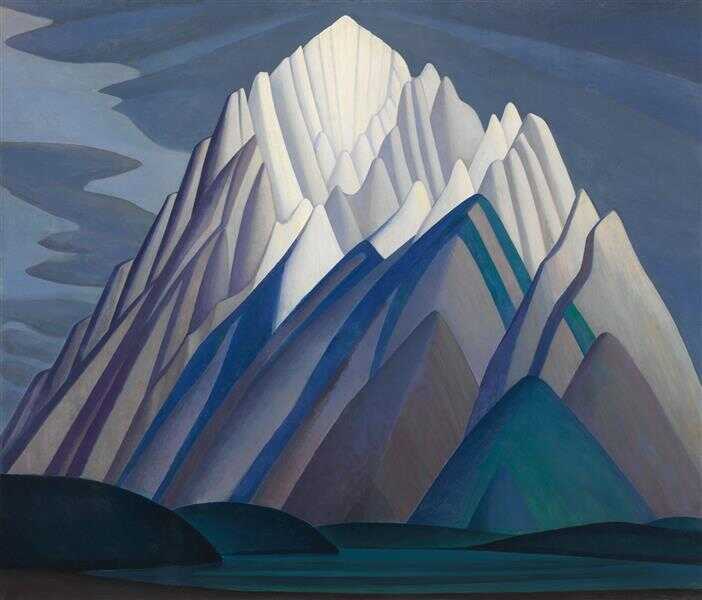
Mountain Forms, 1926 – Lawren Harris
“As I begin inheriting pieces from my Ukrainian grandmother I am finding that I too have culture, woven with arts, crafts, symbols and stories.”
Dochka Rising, 2023 – Brandy Saturley
With this fourth and most recent painting the Lawren Harris painting and period I chose to reference is from his abstract period. ‘Sun and Earth’ painted in 1945 features simplified forms of sunrise and mountains. Again I have put myself in the foreground, only this time I am looking up casting my gaze upwards. My face is dressed in shadows casting stripes across my face and hair. On the lower portion of hair you see symbols and pattern from weaving my Ukrainian grandmother made, passed down to me by my mother. At this time in my life my parents are aging fast and things are changing daily. My mother who was my earliest mentor in art and life, is now requiring our care. I am feeling the need to take time and connect more deeply to my cultural roots, which includes Ukrainian, British and Canadian. Growing up in Sooke on Vancouver Island I spent time with Indigenous friends and family members. I always felt that those with Indigenous heritage were lucky, they seemed to have a real connection to their culture and cultural stories, that I did not feel to my cultural heritage. Growing up in Canada I felt like I had no culture, and now as an adult I realize I do, and this realization has come from watching and learning from our Indigenous cousins. As I begin inheriting pieces from my Ukrainian grandmother I am finding that I too have culture, woven with arts, crafts, symbols and stories. I am also affected by war in Ukraine and moved by the stories of the people and the immigrants to Canada. As my career and work as a Canadian Artist continues to ascend, the depth of my work grows with renewed excitement and explorations across Canada.
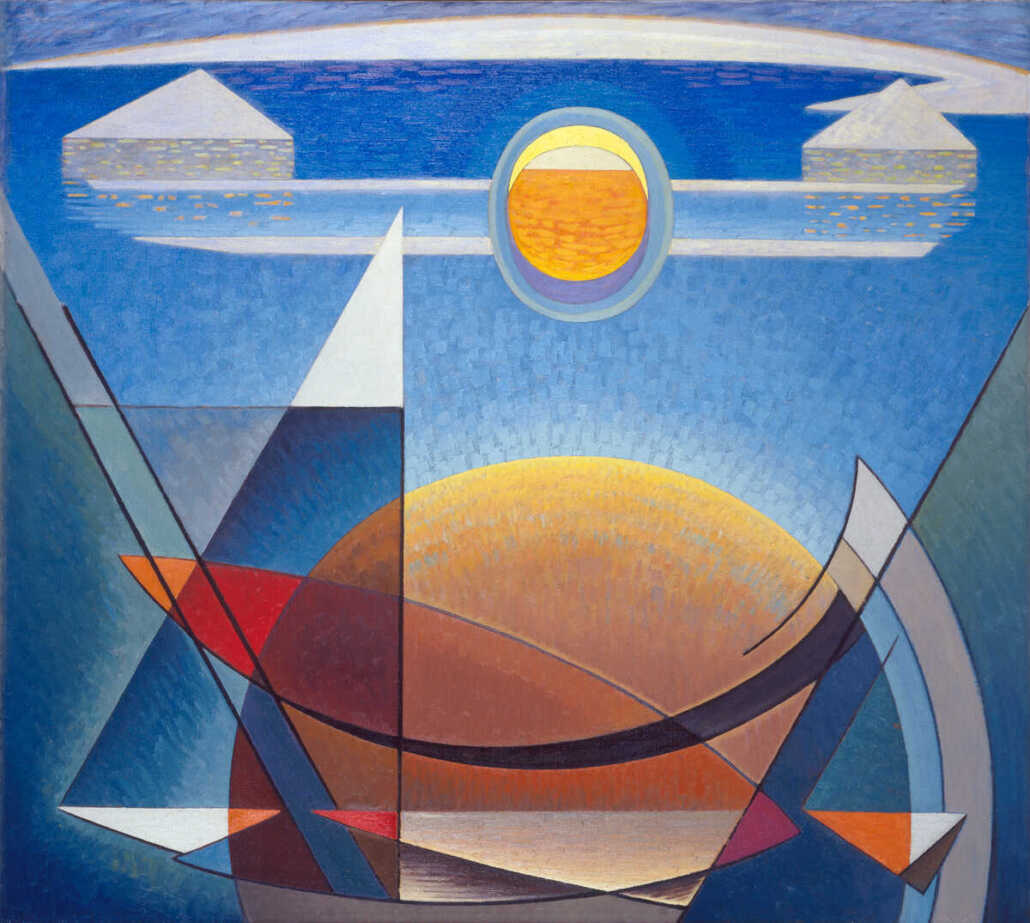
Sun and Earth, 1945 – Lawren Harris
“in a way I feel like I am having a conversation with Harris even though he passed before I was born.”
Lawren S. Harris Self-Portrait, 1932
Lawren Harris and Brandy Saturley are contemporaries painting in different times, in a way I feel like I am having a conversation with Harris even though he passed before I was born. Harris is known for his landscapes that showcase his love for the Canadian wilderness, while my paintings are more focused on the exploration of identity and culture. While we both use painting as a means of expression, our works are vastly different in terms of style, theme, and technique.
Harris’ works are characterized by sharp, clean lines, bold colors, and a geometric approach to composition. His paintings are heavily influenced by his interest in theosophy, a spiritual movement that sought to find universal truth through intuition and mysticism. His work is often described as “spiritual,” with the landscapes he painted appearing otherworldly, with a sense of transcendence.
On the other hand, my paintings are more fluid and organic, with a focus on the human form and its relationship to culture and identity. My work is often marked by vivid colors and layered brushwork, giving my paintings a dynamic and almost tactile quality. I often explore themes of gender, ethnicity, and national identity, with a focus on the social and cultural dynamics that shape our understanding of ourselves and others.
While both artists are celebrated for their distinct styles and contributions to Canadian art, their work represents very different approaches to the medium of painting. Harris’ landscapes are an exploration of the natural world, while my paintings are a celebration of colour, human culture and diversity. However, despite their differences, I believe both of us share a deep love of our country and its people, and our work continues to inspire and engage audiences around the world.

